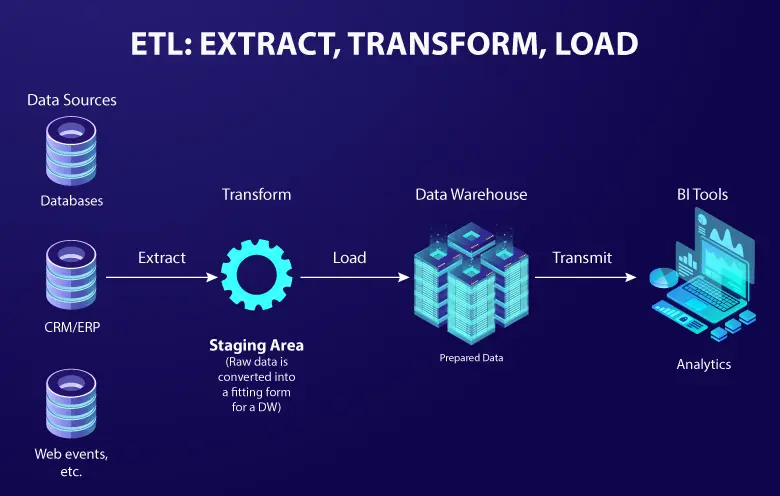Data generated from various sources presents challenges and opportunities for businesses. Companies often face difficulty in extracting and managing meaningful insights from massive datasets. With traditional data analytics methods, it is difficult to maintain the large volume and complexity of disparate data sources. To streamline the process, artificial intelligence (AI) emerges to transform data analytics and create a more significant and efficient future.
According to the survey by Gartner in 2022, 43% of enterprises globally have embraced big data analytics. This leads to a substantial increase in the adoption of analytical tools across diverse industries.
Big data is a massive, complex, and high-velocity dataset. It is a collection of data from various sources and has become essential across diverse industries. Here, we will understand the big data dashboard challenges and the benefits of AI advanced analytics.
Challenges of big data dashboards
Data accuracy and quality
Data quality is essential for determining its effectiveness which depends on accuracy, completeness, consistency, and relevance. Poor or inefficient data results in incorrect insights and impacts decision-making affecting the business growth.
Accuracy
The most important question is the accuracy of the data. Is there any certainty about the data collected and how much trust can be placed in it? The values of each database must be correct and accurate, for example, a registered address must be correct and real, and names must be spelled correctly.
Completeness
The data must be complete and accurate, with all the necessary info for easy understanding of the users. For example, the first and last name is required in the form, but the middle name is optional, still the form is considered complete.
Consistency
An organization must have relevant data in all its systems. For example, the sales data registered in the company’s CRM must match the data registered in the accounting dashboard.
Format
There is a standard format for entering the data, such as type, format, size, etc. For example, dates must have DD/MM/YY format, and names should have only letters.
Integrity
Data used must be valid, ensuring registered connections with all the information. Without interlink, the record may appear as duplicate entries. For example, if your database has numerous registered addresses but not interlinked with any individual, business, or any other entry, it will be considered invalid.
Selecting the right data visualization tools
While selecting the big data tools, most companies emphasize its technical aspects, which are directly related to analysis. This approach may result in implementing solutions with limited visualization capabilities. If you select the wrong tool which doesn’t match business criteria, then you might face consequences such as:
- Difficulties in understanding the data.
- Removes agility from the process of extracting and sharing knowledge within the organization.
- Increases latencies in taking action.
Many data analytical tools, such as Tableau and Microsoft Power BI etc., offer data visualization integration capabilities that help your business grow. If you are not using any of these tools, then try now. Once you select the required tools that meet your business requirements, you will need to:
- Connects with multiple data sources
- Meets your business requirements
- Is it compatible with your current infrastructure
- Cost-efficient
- Offers enhanced security
Analytical and technical challenges
Visual noise
The objects in datasets are related to each other so that users can divide these objects separately on the screen.
Solution: Ensure the data is clean through data governance or information management. Also, remove the outliers from the data so you can create a separate chart for the outliers to remove the visual noise.
Information loss
Big data reduction methods can be used with visible data sets, but they may inadvertently lead to information loss.
Solution: To prevent information loss, it’s essential to choose the correct visualization for data, encode data effectively, and provide clear and concise annotation.
Large image perception
The human visual system has limitations when processing large images and data visualization methods are limited by ratio, device resolution, and physical perception limitations.
Solution: The best solution is converting clustered data into higher-level views, enabling viewers clearer visualization of smaller data subsets. Detail-in-context views, fisheye overviews, and progressive refinement help users comprehend large images in big data visualization.
High rate of image conversation
Users observe data but struggle to respond effectively to changes in the number and intensity of displayed data.
Solutions: Connect with the domain expertise, like Softweb Solutions, for a deeper understanding of the data.
High-performance system required
As big datasets are large, they require high computing power and fast data processing capabilities for real-time data visualization.
Solution: Adopting a grid computing approach allows data storage across multiple machines.
How Softweb Solutions can help with big data analytics consulting services
Data analytics helps companies identify potential opportunities to streamline operations and identify outliers that hinder their progress. Softweb’s AI-driven data analytics services help businesses achieve superior operational efficiencies and drive new revenue generation opportunities. Accelerate decision-making with AI-powered analytics and build a strong foundation with data for true digital transformation.
Suggested: AI and data analytics in sports
Understanding the benefits of AI advanced analytics
Accurate forecasting
Traditional BI tools are unable to delve into intricate details, leading to missed opportunities, and less insightful forecasting compared to advanced analytics. However, advanced analytics powered with algorithms by AI and ML provide comprehensive information across diverse data sources, facilitating the identification of the latest patterns and emerging trends.
Improved decision making
AI advance analytics algorithms and processes enhance the speed and accuracy of business decisions compared to traditional methods. Moreover, pre-emptive strategies are developed giving businesses more agility and a competitive edge.
Mitigate risk
AI model analyzes historical data to forecast risks and anomalies, providing timely warnings. It not only averts risk but also aids in developing effective risk management strategies and enhances decision-making under critical conditions.
To know more about how AI is enhancing big data security purposes. Read our blog: Benefits and challenges in data analytics services
Comparison between data analytics dashboards & AI dashboard services
|
Aspect |
Data Analytics Dashboards |
AI Dashboards Services |
|---|---|---|
| Purpose |
|
|
| Focus |
|
|
| Automation |
|
|
| Complexity |
|
|
| Time Horizon |
|
|
| Functionality |
|
|
| Benefits |
|
|
Conclusion
Big data is the key element to becoming a data-driven organization. It collects and processes real-time data to gain competitive advantages and help accelerate planning, production and launch of new products. AI intelligence dashboard services offers meaningful insights that help to determine cost reduction, save time, and increase overall efficiency.
Do you want to get your big data streamlined to gain a competitive advantage? Avail our data analytics consulting services and talk to our data experts.



